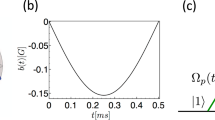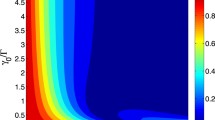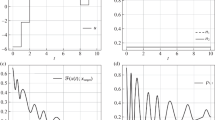Abstract
The main objective of this paper is optimal control of decoherence and dissipation in a system of single qubit. First, we use the Bloch–Redfield formalism to derive the master equation describing the evolution of the qubit state parameterized by vectors in the Bloch sphere. The dissipative effect is described by the driven spin-boson model. By use of the optimal control methodology, we determine the fields that generate Not gate and Hadamard gate. Our optimal control has two components. To solve our optimal control problem, we use the techniques of automatic differentiation (AD) as an alternative to the Pontryagin’s minimum principle (PMP). The later is less straightforward since the master equation is complex. According to our numerical results, we conjecture that in the regime of weak system–bath coupling and low temperature, the driven spin-boson model is quasi-controllable.


















Similar content being viewed by others
Data Availability Statement
This manuscript has no associated data or the data will not be deposited. [Authors’ comment: The paper contents are purely theoretical, and did not need any data.]
References
M.A. Nielson, I.L. Chuang, Quantum Computation and Quantum Information (Cambridge University Press, Cambridge, 2000)
C.H. Bennett, Quantum information and computation. Phys. Today 48, 24 (1995)
N. Khaneja, R. Brockett, S.J. Glaser, Phys. Rev. A 63, 032308 (2001)
N. Khaneja, S.J. Glaser, Chem. Phys. 267, 11–23 (2001)
J. Zhang, J. Vala, S. Sastry, R.B. Whaley, Phys. Rev. A 67, 042313 (2003)
A. Carlini, A. Hossoya, T. Koike, Y. Okudaira, Phys. Rev. Lett. 96, 060503 (2006)
H. Jirari, Phys. Rev. A 102, 012613 (2020)
M. Grifoni, P. Hänggi, Phys. Rep. 304, 229 (1998)
U. Weiss, Quantum Dissipative Systems (World Scientific, Singapore, 1999)
P. Zanardi, M. Rasetti, Phys. Rev. Lett. 79, 3306 (1997)
D.A. Lidar, I.L. Chuang, K.B. Whaley, Phys. Rev. Lett. 81, 2594 (1999)
J. Preskill, Proc. R. Soc. Lond. A 454, 385 (1998)
E. Knill, R. Laflamme, L. Viola, Phys. Rev. Lett. 84, 2525 (2000)
J. Wang, H. Wiseman, Phys. Rev. A 64, 063810 (2001)
L. Viola, S. Lloyd, Phys. Rev. A 58, 2733 (1998)
L. Viola, E. Knill, S. Lloyd, Phys. Rev. Lett. 82, 2417 (1999)
L. Viola, E. Knill, S. Lloyd, Phys. Rev. Lett. 83, 4888 (1999)
L. Viola, E. Knill, S. Lloyd, Phys. Rev. Lett. 85, 3520 (2000)
P. Zanardi, Phys. Lett. A 258, 77 (1999)
D. Vitali, P. Tombesi, Phys. Rev. A 59, 4178 (1999)
C. Uchiyama, M. Aihara, Ibid 66, 032313 (2002)
M.S. Byrd, D.A. Lidar, Quantum Inf. Process. 1, 19 (2002)
M.S. Byrd, D.A. Lidar, Phys. Rev. A 67, 012324 (2003)
V. Protopopescu, R. Perez, C. D’Helon, J. Schmulen, J. Phys. A Math. Gen. 36, 2175 (2003)
M. Itano. Wayne, Phys. Rev. A 41, 2295 (1990)
P. Facchi, S. Tasaki, S. Pascazio, H. Nakazato, A. Tokuse, D.A. Lidar, Phys. Rev. A 71, 022302 (2005)
L. Viola, J. Mod. Opt. 51, 2357 (2004)
X. Hu, W. Pötz, Phys. Rev. Lett. 82, 3116 (1999)
L.S. Pontryagin, The Mathematical Theory of the Optimal Process (Wiley-Interscience, New York, 1962)
L. Hascoët, V. Pascual, A.C.M. Trans, Math. Softw. 39, 20 (2013)
T. Tamayo-Mendoza, C. Kreisbek, R. Lindh, A. Aspuru-Gusik, ACS Cent. Sci. 4, 559 (2018)
A.E. Bryson, Y.C. Ho, Applied Optimal Control (Hemisphere, New York, 1975)
Shi, H. Rabitz, J. Chem. Phys. 92, 364 (1988)
M. Grace et al., J. Phys. B At. Mol. Opt. Phys. 40, S103–S125 (2007)
G.D. Mahan, Many Particles Physics (Plenum Press, New York, 1999)
B. Krummheuer, V.M. Axt, T. Kuhn, Phys. Rev. B. 65, 195313 (2002)
U. Hohenester, G. Stadler, Phys. Rev. Lett 92, 196801 (2004)
J. Zhang, W. Pötz, Phys. Rev. B 48, 11583 (1993)
I. Rousochatzakis, Y. Ajiro, H. Mitamura, P. Kögerler, M. Luban, Phys. Rev. Lett 94, 147204 (2005)
A.E. Allahverdyan, R.S. Garcià, Th.M. Nieuwenhuizen, Phys. Rev. Lett. 93, 260404 (2005)
Yu. Makhlin, G. Schön, S. Shnirman, Rev. Mod. Phys. 73, 357–400 (2001)
P. Nalbach, Phys. Rev. A 90, 042112 (2014)
L. Arceci et al., Phys. Rev. B 96, 054301 (2017)
A.J. Leggett, S. Chakravarty, A.T. Dorsey, M.P.A. Fisher, A. Garg, W. Zwerger, Rev. Mod. Phys. 59, 1 (1987)
G. Wendin, V.S. Shumeiko, in Handbook of Theoretical and Computational Nanothecnology, vol. 3, ed. by M. Rirth, W. Schommers (ASP , Los Angeles, 2006), pp. 223–309
J.M. Martinis, S. Nam, J. Aumentado, C. Urbina, Phys. Rev. Lett. 89, 117901 (2002)
M. Neeley et al., Nat. Phys. 4, 523 (2008)
E. Hoskinson et al. Phys. Rev. Lett. 102, 097004 (2009)
H. Jirari, F.W.J. Hekking, O. Buisson, Europhys. Lett. 87, 28004 (2009)
J.F. Poyatos, J.J. Cirac, P. Zoller, Phys. Rev. Lett. 78, 390 (1997)
M. Thorwart, P. Hänggi, Phys. Rev. A 65, 012309–1 (2001)
H.P. Breuer, F. Petruccione, The Theory of Open Quantum Systems (Oxford University Press, Oxford, 2002)
M. Morillo, C. Denk, R.I. Cukier, Chem. Phys. 212, 157 (1996)
K. Blum, Density Matrix Theory and Applications, 2nd edn. (Plenum Press, New York, 1996)
L. Hartmann, I. Goychuk, M. Grifoni, P. Hänggi, Phys. Rev. E 61, R4687 (2000)
G.H. Golub, C. Van Loan, Matrix Computations, 2nd edn. (John Hopkins University Press, Baltimore, 1989)
H. Jirari, Europhys. Lett 87, 40003 (2009)
C. Zhu, R.H. Byrd, J. Nocedal, ACM Trans. Math. Softw. 23(4), 550–560 (1997)
H. Geen, R. Freeman, Band selective radiofrequency pulses. J. Magn. Reson. 58, 442–457 (1984)
V. Ramakrishna, M.V. Salapaka, M. Dahleh, H. Rabitz, A. Pierce, Phys. Rev. A. 51, 960 (1995)
S.G. Schirmer, H. Fu, A.I. Solomon, Phys. Rev. A. 63, 063410 (2001)
D. D’Alessandro, preprint arXiv:quant-ph/0110120 (2001)
Author information
Authors and Affiliations
Corresponding author
Rights and permissions
About this article
Cite this article
Jirari, H. Implementation of one-qubit gates using optimal control theory for a dissipative system. Eur. Phys. J. B 94, 217 (2021). https://doi.org/10.1140/epjb/s10051-021-00221-9
Received:
Accepted:
Published:
DOI: https://doi.org/10.1140/epjb/s10051-021-00221-9




